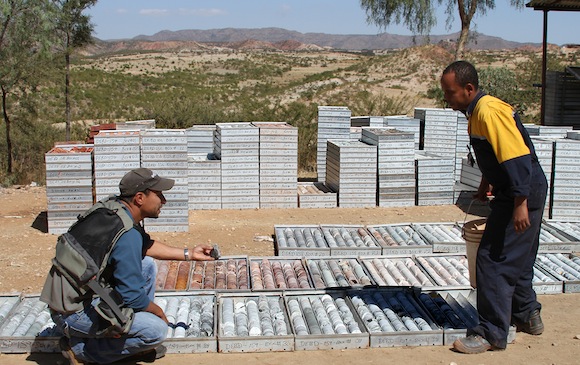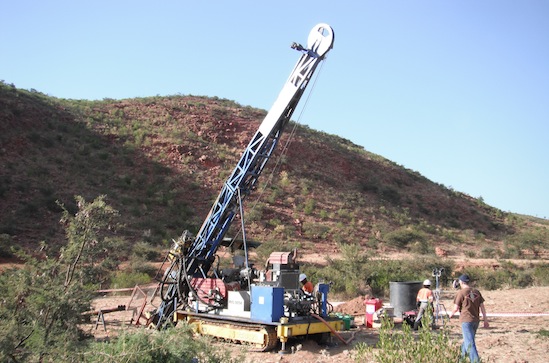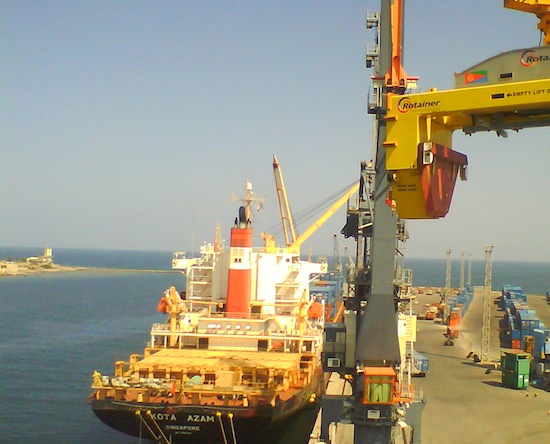I must admit i was wavering at one point.But these guys doube and Real are proving over and over that honesty in the investment world is alive and well.NO DILUTON as they always said.Many dismissed their views but they were correct when this truth was first posted here a year ago.Credit to whom credit is due is some thing severely lacking in this thread. Bravo guys.Great article mycash.Zadman easy he observed something that is fact. You have nothing to complain about.
mycashsgoesohno wrote:
TICKERS: SGC; SGCNF
 It's been a very active decade filled with milestones for Sunridge Gold, and now following the September signing of a comprehensive permitting agreement with its partner, the government of Eritrea, the Canadian junior is set to begin production in 2016. In this interview with The Gold Report, President and CEO Michael Hopley discusses the riches of his company's copper, gold, zinc and silver deposits and looks forward to becoming as successful as Nevsun has been.
It's been a very active decade filled with milestones for Sunridge Gold, and now following the September signing of a comprehensive permitting agreement with its partner, the government of Eritrea, the Canadian junior is set to begin production in 2016. In this interview with The Gold Report, President and CEO Michael Hopley discusses the riches of his company's copper, gold, zinc and silver deposits and looks forward to becoming as successful as Nevsun has been.

Courtesy Sunridge Gold
Management Q&A: View From the Top
The Gold Report: Why did Sunridge Gold Corp. (SGC:TSX.V; SGCNF:OTCQX) choose to work in Eritrea?
Michael Hopley: We chose Eritrea because of the tremendous opportunity it presents. Members of our geological team had worked on Nevsun Resources Ltd.'s (NSU:TSX; NSU:NYSE.MKT) very large volcanogenic massive sulfide (VMS) Bisha deposit in western Eritrea. They were aware that there were several other large VMS deposits in Eritrea that had not been properly explored.
TGR: How big is your Asmara project?
MH: VMS occurrences appear in clusters, in districts that are tens of kilometers long and wide. Asmara is essentially a VMS district we've had to ourselves. We have so far defined six deposits all within a 30–45 minute drive from Eritrea's capital, Asmara.
"Asmara is essentially a VMS district we've had to ourselves."
The crown jewel and the center of gravity of the Asmara project is the Emba Derho deposit. This is a 70 million tonne (70 Mt) resource containing over 1 billion pounds (1 Blb) copper and 2.1 Blb zinc, 506,000 ounces gold and 19.5 million ounces silver.
There are two other small deposits within 7 kilometers of Emba Derho: Adi Nefas and Gupo Gold. Adi Nefas is a small deposit, just slightly less than 2 Mt, but it is very high grade: over 10% zinc and 1.8% copper. It also averages 3.3 grams per tonne (3.3 g/t) gold and 115 g/t silver. This would be the only underground mine at the project. Gupo Gold has an Indicated gold resource of 952,000 tonnes at 1.53 g/t and an Inferred resource of 1.8 Mt at 1.85 g/t.
Our fourth major deposit is Debarwa, 45 minutes to the south. It contains 3.3 Mt, with over 200 million pounds (200 Mlb) copper, 70 Mlb zinc and significant gold and silver. Debarwa is also significant because it hosts the DSO Zone—Direct Shipping Ore—which averages 16% copper with gold and silver.
 Geotech Drilling at Debarwa. Photo courtesy of Sunridge Gold.
Geotech Drilling at Debarwa. Photo courtesy of Sunridge Gold.
TGR: You have two pipeline projects as well, correct?
MH: Yes, these are Adi Rassi and Kodadu, which are not as advanced as the four in the feasibility study. Adi Rassi contains a 16 Mt resource at 0.5% copper and 0.3 g/t gold. Kodadu is a 1 Mt resource at 1.25 g/t gold and 1.6 g/t silver.
TGR: What is your experience in the mining business?
MH: I'm a geologist by training and have been in the business for more than four decades. I've been associated for the last 10–15 years with junior companies based in Vancouver, notably, Bema Gold Corp., Arizona Star Resources Corp. and Tournigan Energy Ltd. So I have extensive experience with running public companies, and I have been running Sunridge for 11 years.
TGR: Tell us about the qualities of your executive team.
MH: We have a lean, agile, multitasking team of which I'm quite proud. There are essentially four of us in Vancouver. Greg Davis, our vice president of business development, has been with us since 2007. He worked at Bisha for two years, so he understands Eritrea and VMS deposits. Scott Ansell, our vice president of project development, has been with us since 2009. He was a project manager at Bisha and was formerly director of engineering studies at Amac. David Daoud, our exploration manager and an expert on exploring VMS deposits, was part of the Bisha discovery team and joined us in 2005.
TGR: Asmara is owned 60% by Sunridge and 40% by the Eritrean National Mining Corp. (ENAMCO). How supportive a partner has the government of Eritrea been?
"We can now move forward to production next year."
MH: We had lengthy negotiations regarding the structure of the joint venture company and what the government would pay for with its initial 30%. Now that we have agreed on terms and conditions, the government is very supportive and has delivered its promised money on time. It's a good relationship.
TGR: Talk about the significance of your Sept. 11 agreement with the Eritrean Ministry of Energy and Mines.
MH: It's hugely significant for us. Four very work intensive years of prefeasibility studies, feasibility studies, environmental impact studies and social engagement programs have culminated in this agreement, which permits Emba Derho, Adi Nefas, Gupo Gold and Debarwa. We can now move forward to production next year.
TGR: Asmara will be developed in phases. How will this work?
MH: Our feasibility study delineated a three-phase startup of Asmara. This is a rather excellent and unique way for a junior such as Sunridge to develop such a large project. Debarwa will be the catalyst. It has 116,000 tonnes DSO of 16% copper and 3 g/t gold just 20 meters beneath the surface. This DSO has the qualities that are highly coveted by smelters, and mining it will allow us to stage the startups for phases 1, 2 and 3.
TGR: So the earlier phases will pay for the later ones?
MH: To some degree. Phase 1A, the DSO, could pay for phase 1B, the gold heap-leaching operation at Debarwa. Whether we go ahead with phase 1B will depend on the gold price. In any event, 1A will generate $50–60 million ($50–60M), which will most likely be used to jumpstart phase 2, which has a capital expenditure (capex) of $200M+.
TGR: How much cash does Sunridge have?
MH: About $1.3M. That doesn't sound like much, but we also have substantial credits from ENAMCO, our JV partner. Our expenses are small, and ENAMCO will fund the next $5.5M of the project. In addition, our partners owe us $13.3M, which we will begin receiving after phase 1 financing is finalized.
TGR: What about the capex for the rest of the Asmara project?
MH: Phase 2 and 3 capex combined will be ~$350M, and we will have various ways of financing that. We will have a cash component put away from phase 1, but phases 2 and 3 will be financed primarily through debt. Having phase 1 operating will make the financing of 2 and 3 that much easier and more tangible.
TGR: Are you considering offtakes?
MH: Everything is on the table. We are talking to various offtake companies and middle traders for phase 1. They have indicated a desire to be involved in phases 2 and 3 as well.
TGR: When will Asmara go into full production?
MH: Full production means phase 3, and that should begin in 2019. However, the first phase of DSO copper production is scheduled for late next year. Once full production is achieved, the project will average yearly production of 65 Mlb of copper and 184 Mlb of zinc, with 42,000 ounces of gold and 1 million ounces of silver.
TGR: How long is Asmara's mine life?
MH: The feasibility study says 15 years, but as you know, once VMS mines go into production, they typically last twice as long as forecast. Particularly in the case of the Asmara project, which has significant exploration and expansion potential.
TGR: You called Asmara "a VMS district we've had to ourselves." How prospective could it be?
"Eritrea has been a great place to work and operate."
MH: It is hugely prospective, and with some more exploration dollars in the ground, I have no doubt we will find a lot more. You have only to look at Nevsun's recent tremendous success in defining more ounces of gold and more pounds of copper and zinc. We understand the Eritrean geology and geophysics, and once we achieve production on the reserves we have already defined, we expect to resume exploration drilling.
TGR: What are your plans for Adi Rassi and Kodadu?
MH: They need more drilling. There are some very compelling targets on both, and expansion drilling when we resume exploration work.
TGR: Have Sunridge shares suffered from an "Eritrean discount"?
MH: Yes, the perception of Eritrea has been one of our major challenges. We feel it has been a great place to work and operate and Nevsun is a very good example of this, although Nevsun's share price does not come close to reflecting the health of that company and the value of its deposit. In our case, we expect the discount to be reduced significantly when we begin production next year.
TGR: Would you describe Eritrea as a stable country and a good mining jurisdiction?
MH: Yes, it has been quite stable for the decade we have operated there. Many African countries have in recent years moved the goal posts and changed the rules of the mining game. Eritrea has not.
TGR: Nevsun has been the big Eritrean mining success. Could Sunridge be as successful?
MH: Yes, indeed. Our operation in full production is certainly on a similar scale to Bisha. However, our operations are much easier. We are a quarter of Bisha's distance to the port facility for shipping the product, and we are not in remote Eritrea; we are near a major city, Asmara. This means our workforce is readily available and doesn't have to live in mining camps.
 Rotainer Crane at Massawa. Photo courtesy of Sunridge Gold.
Rotainer Crane at Massawa. Photo courtesy of Sunridge Gold.
We have a major international airport essentially right on the project. We have roads, we have power, and we have water. The power is not sufficiently reliable for operations but is quite sufficient for the work we are doing now. We can stay at a really good hotel—a first-world hotel—get out of bed in the morning and go by taxi to any corner of our property within 30 minutes.
TGR: Since the Sept. 11 agreement was announced there's been a significant uptick in Sunridge's share price. Do you anticipate that continuing?
MH: Yes, I do. I think once people understand what we have in this mining agreement, things will only improve for our shareholders. We now are working to finalize the project capital for phase 1 through non-dilutive methods. We expect the market to view this as another major milestone for Sunridge Gold.
TGR: Michael, thank you for your time and your insights.
Michael Hopley is the president, CEO and a director of Sunridge Gold Corp. He has over 30 years of international experience as a geologist and exploration manager for resource companies in the precious metals and base-metal sectors with companies such as Gold Fields Mining, Bema Gold Corp. and Tournigan Energy Ltd. He was part of the team that discovered the large Refugio and Cerro Casale gold and gold/copper deposits in Chile. For the past 15 years, he has managed a number of publically traded junior resource companies and held a number of executive and board positions with companies conducting exploration in various parts of the world.